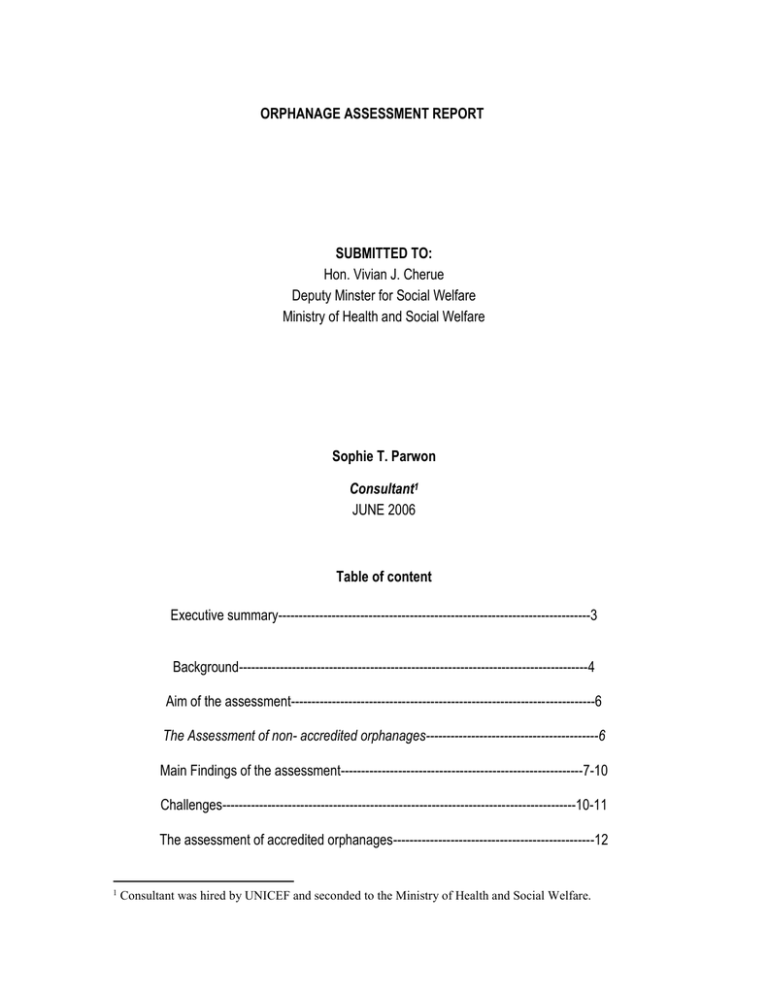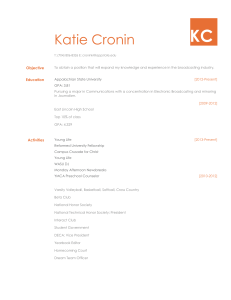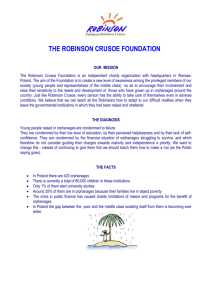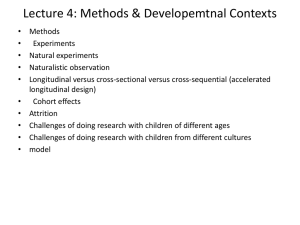ORPHANAGE ASSESSMENT REPORT SUBMITTED TO: Sophie T. Parwon
advertisement

ORPHANAGE ASSESSMENT REPORT SUBMITTED TO: Hon. Vivian J. Cherue Deputy Minster for Social Welfare Ministry of Health and Social Welfare Sophie T. Parwon Consultant1 JUNE 2006 Table of content Executive summary----------------------------------------------------------------------------3 Background-------------------------------------------------------------------------------------4 Aim of the assessment--------------------------------------------------------------------------6 The Assessment of non- accredited orphanages------------------------------------------6 Main Findings of the assessment-----------------------------------------------------------7-10 Challenges--------------------------------------------------------------------------------------10-11 The assessment of accredited orphanages-------------------------------------------------12 1 Consultant was hired by UNICEF and seconded to the Ministry of Health and Social Welfare. Main Findings of the assessment------------------------------------------------------------13-15 Closure of orphanages-------------------------------------------------------------------------16-17 Observations-------------------------------------------------------------------------------------17 Recommendations-------------------------------------------------------------------------------18 Executive summary This report covers the period from August 2005 to June 2006 and highlights major activities implemented in relation to the child protection term of reference in collaboration with Child Protection Network Task Force headed by Ministry of Health and Social Welfare. This exercise was supported by UNICEF/Liberia to create capacity building that would enhance child welfare and protection of children in orphanages in Liberia. This summary presents an overview of care and services provided to children in orphanages throughout the country. Also, included in this report are some recommendations for consideration; and if adopted and implemented, which could improve Children’s Rights and fundamental care and protection of children in orphanages. Essentially, since 1991 to present, several measures have been taken to improve the care and protection of children living in orphanages in Liberia, but had limited results. This is mainly because of the internal conflict, and other social ills that affected Liberian families/children for nearly two decades. Children who were separated from their parents during the war, and other children who lost their parents during the same crisis and others who were abandoned by fleeing families found themselves in sub-standard orphanages that were run by individuals and some local organizations. These individuals and organizations practices did not conform to social welfare and child protections standards. By about 2004, the Protection Task Force comprising of UNICEF, Save the Children UK, WFP, DON BOSCO, ICRC, Ministries of Justice, Education, Planning, and Gender and Development, Union of Orphanages, Action Aid Liberia, Office of the Chief Justice, Youth Aid, Liberia National Police, Mother Patern, World Vision Liberia and led by the Ministry of Health and Social Welfare adopted some significant steps to improve the care and protection of children living in orphanages. . The work started in 2004 formed the foundation for the consultancy assistance rendered to the MOH/SW by UNICEF in 2005 August to provide leadership empowerment and facilitate child welfare Protection through the Task Force. From August 2005 to June 2006, the child protection network task force implemented the following activities: Assessment of 111 orphanages nation wide with 4,840(2,648 male; 2,125 female) children recorded Documentation of 680 children in Nimba and Grand Gedeh Counties 2 Closure of 17 orphanages Family tracing and reunification of 49 children from an orphanage in Nimba County led by IRC; Reunification of 361 children from five of the 17 orphanages in Monrovia, Montserrado County Accreditation and certification of 50 orphanages by MOH/SW; Training of 20 MOH/SW social workers on how to conduct assessments of orphanages and how to carry out systematic information dissemination and education of communities on prevention of separation of children from their parents; Training of 20 MOH/SW social workers on how to monitor and supervise welfare institutions; Review of the Ministry of Health & Social Welfare 1999 guidelines and standards for the operation of orphanages in Liberia; Development of mechanisms for regular monitoring and supervision of accredited orphanages. This work would not have been implemented without the assistance and collaboration of UNICEF/Liberia and the Child Protection Task Force on orphanages. My special gratitude and appreciation go to all those who worked with me in the Ministry of Health and Social Welfare, The Union of Orphanages, Save The Children UK, and UNICEF Liberia, during the period of the assessment. 1. BACKGROUND 3 During the 14 years of the Liberian civil crisis, many orphanages were established to cater for children who had been abandoned or neglected by their parents/families. Children who were separated from their families and/or children whose parents died prior to the 1989 war constituted only ten (10) orphanages operating throughout the country. By 1991, the number of orphanages rapidly increased from 10 to 121 in number. This proliferation of orphanages prompted the establishment of the Board of Accreditation of Welfare institutions (BAWI) in 1993. The Board was charged with the responsibility to assess, monitor, supervise, and grant accreditation to orphanage proprietors who meet basic standards and criteria set in the guidelines for the operation of child welfare institutions Liberia. However, due to continue unrest and insecurity posed on the country at the time, BAWI virtually collapsed in 1996. Thus in 1998, the deplorable conditions of children living in orphanages drew the attention of child protection agencies working in Liberia; UNICEF commissioned two independent assessments to determine the over all compliance to guidelines and policies governing orphanages, and also to determine the population of children situated in the orphanages. The outcome from these assessments indicated alarming increase in the number of children placed in orphanages (14,000 children in total from 117 orphanages, and nearly 60% of the population did not meet the standard criteria. About 45% of the orphanages assessed were providing sub-standard services to the children, most of whom were not real orphans. The assessment recommended that 1). All substandard orphanages should be subsequently closed and/or 2). Family tracing activities carried out to reunite non orphan children to their respective families. Following the 1998/99, assessment of orphanages the National Child Protection Network Task Force on orphanages was re-established and was charged with the following responsibilities: a) To implement the recommendations of the 1998/99 recommendations; b) To monitor the care and protection of children in orphanages; c) To scrutinize application for accreditation and advise the BAWI accordingly; d) To promote the deinstitutionalization of children; e) To design community empowerment programs for protection and care of children in families and communities f) To coordinate, assess, supervise and the work of orphanages. At this particular time the membership of the Protection Task Force comprised of the Ministry of Health/Social Welfare, SC-UK, UNICEF, Concern Christian of Liberia, American Refugee Committee, Ministry of Youth and Sports, Don Bosco Homes, Voice of the Future, YMCA, UNHCR, Organization for Children and Adolescent Mothers (OCAM), Mother Patern College of Health Sciences, WFP, ICRC, Juvenile Division/Liberia National Police and Union of Liberian Orphanages. Between 2001 and 2003, the Protection Task Force was unable to implement the recommendations of the 1998/99 assessment due to the renewed fighting as well as the prevailing political situation. The peace accord which ended the war in August 2003 and the establishment of the Transitional Government of Liberia and the consequent deployment of the UN Peacekeeping Mission brought the much needed peace in Liberia. The peaceful conditions in the country created the opportunity for another assessment of orphanages in April 2004. This assessment covered Montserrado and lower Margibi Counties and 96 orphanages with a case load of 4,792 children (2,671 males and 2,121 females) were reached in the assessment. At this time, the assessment 4 recommended the closure of 39 sub-standard orphanages which failed to comply with the guidelines and policies set by MOH and child Welfare agencies. Accordingly, 40 orphanages were duly accredited while 17 orphanages were placed on probation. Unfortunately, these recommendations were not immediately implemented because the Ministry of Health granted delinquent orphanages a grace period of six months as an opportunity to either improve their standards and/or be closed. There after several challenges ranging from political influence patronage to lack of commitment by the owners of orphanages made it very difficult for the Protection Task Force to implement the recommendations. However, it was only in December 2004 that three orphanages - two of which were high profile were ordered closed and only because of the influence of UNMIL following an investigation by the Major Crimes Unit of United Nations Mission in Liberia. In August 2005, UNICEF hired and assigned a consultant to provide technical support to the Ministry of Health and Social Welfare. In November 2005, a nationwide assessment of orphanages was attempted for the first time. 59 orphanages with 2,882 children, (1,587 males and 1,295 females) were assessed in order to assist the Bureau of Social Welfare at the MOH/SW to enforce the implementation of the recommendations and to monitor the care and protection of children in orphanages. 2. AIM OF THE ASSESSMENT The aim of the assessment of orphanages is to improve the care and protection of children in orphanages in Liberia. To also gather information on the quality of care services being provided to determine the capacity of the orphanages to provide care to the children. 3. SPECIFIC TASKS: 1. To complete the review of the guidelines for operating orphanages in Liberia. 2. To facilitate the assessment of all orphanages in Liberia with the view to close sub standard orphanages and accredit those providing quality care and services. 3. Review and update the existing tool for assessing orphanages. 4. Prepare training for the Child Protection Network Task Force members on how to use the updated tool. 5. To support the reunification of non-orphaned children. 6. To ensure that the orphanages that have been recommended for closure by the assessment of April 2004 are closed. 7. To develop mechanism for regular monitoring and supervision of accredited orphanages. 4. The Assessment of non- accredited orphanages The assessment of orphanages started with the development of a work plan detailing activities, timeframe, logistics and personnel needed. Thereafter, a two phase plan was developed to assess orphanages throughout the country. Phase one plan was designed for Nimba, Bong, Grand Bassa Counties and parts of Montserrado and Margibi counties that were not covered in the April 2004 assessment. Phase plan two was designed to cover the remaining eight (8) counties. The Protection Task Force on Orphanages led the development of the assessment work plan. 4.1 Methodology 5 The tool for gathering information was designed and circulated to the Protection Task Force members for input, thereafter it was piloted in two orphanages in Monrovia. The assessment tool was revised after the piloting and the assessment team members were trained on how to use the tool. The main method employed during the assessment was direct interviews with children living in the orphanages, orphanage proprietors, and/or caregivers and community members of the communities living near the orphanages. Both qualitative and quantitative information was gathered and photographs of interesting scenes were taken. (See appendix A for Assessment Tool) 4.2 Information/sensitization .The major goal of the assessment is to provide and disseminate information relevant to child care and protection services. Thus, general public education, community awareness and information on prevention of separation of children from families and the planned assessment was carried out through radio talk shows. Radio announcements in English and local dialects were aired through community radios to target orphanage populations in both urban and rural communities. Also, this process was adopted to encourage and support the participation of major stakeholders in the assessment and implementation of Child Welfare policies in the Country. In this light, the Deputy Minister of MOH/SW personally wrote letters to all County Superintendents, Child Protection Agencies (CPA) operating on county and districts levels, UNMIL Military Section, UNMIL CIVPOL, UNMIL Human Rights and Protection, UNMIL Civil Affairs, the Child Protection Network, Union of Orphanages, all Task force members, media institutions, police zones and related government ministries to support the process. The Deputy also informed County Health Officers to support the assessment through radio message from the radio room at the Ministry of Health & Social Welfare. 4.3 Assessment Four assessment teams comprising of two supervisors from the Protection Task Force and four representatives of CPAs in the county, UNMIL Human Rights Officer personnel were set up. The Supervisors were given their TOR which was developed under the Child Protection Network Task Force. The teams were given orientation on the assessment tools, a package which include 20 copies of assessment instrument, the list of UNMIL Human Rights Officers assigned in each county, list of Child Protection Agencies (CPA) operating in each county, the names and contacts of the Ministry of Gender and Development County Coordinators, the Supervisors’ TOR, assessment guidelines and daily analysis recording from. The nation wide assessment of orphanages took ten days, the first two days were devoted to community awareness programs, briefing of CPAs operating in the targeted county, mapping out of orphanages, meeting forums and the introduction of the assessment teams to Civil and Local Administrators at the county levels, proprietors of orphanages, community members and groups, and children living in orphanages to explain the purpose of the assessment. Days 3-9 were used for the actual collection of data and other information from the orphanages. At the end of each day, the team met to analyze the data, share observations of the day’s activities, and write the daily notes. On day ten, the team briefed the CPAs at the county level on the preliminary findings from the assessment. The Supervisor of each team presents daily briefings to MOH/SW on the progress, constraints, and observations on the assessment exercises. 6 4.4 Main Findings of the assessment 2,882 children (1,587 males and 1,295 females) were found living in the 59 orphanages that were assessed. The disaggregated data is as follows; children aged 0-5=265, children aged 6-12= 922, children aged 13-17=505 and children above 18 were 44. This disaggregated data excludes data from Nimba, Bong and Grand Gedeh counties where the assessment teams failed to disaggregate the data by age. The data shows that there are more male children living in orphanages than females. The highest disaggregated population (6-12) aged bracket (922) while children aged 18 and above scale fewest (44) than the norm. This statistics should make planning for their exit somehow easier. 25 of the 59 orphanages assessed are found to be operating within the minimum standards required by the 1999 guidelines, while 35 orphanages were providing sub-standard care services: very much below the minimum standards of 1999. Assessment Teams also found that River Gee had no orphanages; instead families and communities in this county used traditional care arrangements to care for orphaned children, while Grand Kru and River Cess were not accessible at the time due to bad road condition. 4.4.1 Registration and Accreditation All the 59 orphanages assessed are either owned by private individuals or by faith based organizations. 46 of the orphanages assessed were not registered or accredited and were therefore operating without the knowledge of MOH/SW while 13 of them had accreditation documents dated from 1996-2004. 4.4.2 Placement of children and Record System Of the 59 orphanages assessed, twenty four (24) are located in Nimba and Grand Bassa Counties with a caseload of 1, 286(684 males and 602 females). These two Counties recorded the highest intake of children. None of the 59 orphanages assessed have proper documentation and proper record keeping systems. The assessment teams also encountered difficulties in gathering the children’s social history information. Some children were able to give information about their social history but only when the proprietor or the caregivers were absent. Some children informed the assessment teams that they were mobilized by the church members from out station branches of churches owned by the proprietors. Some children said that they came to the orphanages through individuals called “recruiters” who mobilized them from villages and towns for placement in orphanages. While community members alleged that the “recruiters” receive some reward either in cash or kind from the proprietors of the orphanages. This information only reflects oral data collected from Todee, and Klay Districts from Montserrado and Bomi Counties respectively. Other children said that they had been recruited to the orphanages by the proprietors themselves or their relatives and friends. The Assessment Teams also fund that changing of children’s names on admission into an orphanage was common 7 practice and that generally, the children take on the names of the proprietor of the orphanage or the names of the caregivers. On the other hand, Nimba Assessment Team learnt that babies whose mothers die during child birth are usually taken to the orphanages by traditional birth attendants or other relatives. Information regarding this practice was collected in Ganta and other towns in Nimba County. 4.4.3 Health and Education Generally, there are no medical facilities in all orphanages assessed. These orphanages did not even have first aid kits, nor did they have visiting medical doctors or nurses. There was no nurse nor any other qualified health worker employed in any of the orphanages assessed. Children who fall sick are generally taken to near by clinics for treatment if one was found in the vicinity. Where there is none, the caregivers resort to buying drugs from hawkers and administering the same to the sick children. 40 of the orphanages assessed operate elementary schools while 2 operate junior schools. 95% of the teachers found working in these schools are untrained high school students high school graduates. The older children are made to teach in orphanage operated schools since they can not afford to pay trained teachers. All the schools lack basic school materials and other teaching aids, library and science laboratories. Generally, the orphanage buildings were used for several purposes including worship, sleeping quarters, school building, and dwelling place for the staff and their families. On the contrary, orphanages in big cities have access to safe drinking water through the community hand pumps built by NGOs and faith based organizations but many orphanages in the rural areas do not have access to safe and clean water. 4.4.4 Food Supplies and other donations Christian Aid Ministries (CAM) and World Food Programme (WFP) are the two main organizations that supply food to orphanage institutions in Liberia; besides, there are also other overseas faith based donors and private individuals who some times assist orphanages with food, cash, and non food items. Essentially, food aid appears to be one of the contributing factors for the high placement of children in orphanages because the more children an orphanage has the more food ration it gets. This is perhaps one of the reasons why many non-orphaned children are placed in orphanages in order to increase food supplement. Despite all the assistance some of the orphanages received, the proprietors and caregivers consistently complained that they do not have enough food for the children. Thus, Food and non-food items are always misappropriated by proprietors and caregivers. It was widely mentioned by some patriotic community members that items form the orphanages are often sold to venders as soon as food came to the orphanages. Vital information solicited from community dwellers suggest that resources for the children were always shared with other family members of the supporting staff. This claim support evidence that staff living in the orphanage with their families paid themselves with the basic food supplements donated to these orphanages since they were not receiving any cash compensation from their employers. Contrary to this bad practice, 8 Christian Aid Ministries supported some orphanages, and their support staff, including some form of financial assistance. During the assessments, the teams discovered 30 of 44 boys and girls who are aged 18 and above in the orphanages were not present for head count. Further inquiry maintained that they had gone out to look for additional food to either augment the limited supply left after the venders took their portion or to cater for extra funding through farm work for their own wellbeing. In the rural areas, some of the orphanage proprietors maintained farms on which the children are normally sent to plant and/or harvest crops and other food items. On the contrary, the teams received other vital information indicating that “in towns and big cities, the older children are used as bread winners engaged in petty trading to provide funding in order to support the orphanages”. Unconfirmed reports also suggest older girls served as caregivers for the younger children in most orphanages due to lack of adequate supervision and/or shorted of staff. 4.4.5. Accommodation/Sleeping quarters All the orphanages assessed have deplorable and congested sleeping quarters which contributed to poor health and hygiene of the children. Also, most orphanage facilities have no ventilation. In most cases, boys and girls sleep in separate rooms but with no doors, screens, ceiling, and locks. There are no mattresses so the children mostly sleep on relief blankest on the bare floors. 4.4.6 The ratio of caregivers to children On the average the ratio of caregiver to children is 1:15, however, Sinoe County recorded the ratio of 1:76 followed by Maryland 1:45, Garpolu County 1:28 , Margibi 1:19, Grand Gedeh, Grand Bassa and Bong 1:14; Nimba 1:13 and Montserrado recorded the lowest. 1:10, the number of caregivers for Cape Mount County was not recorded. 4.4.6 Constraints and challenges encountered during the assessment Obtaining social history of the children was perhaps the biggest constraint that the assessment teams encountered. It is still difficult to get a clear picture of the children who are real orphans and those who are not but are living in the orphanages. The fact that some of the proprietors have changed the names of the children made it difficult to trace their families especially for children brought in to the orphanages when they were very young. The delay in completing the assessment of orphanages in parts of Montserrado and Margibi counties created major set back in completing the assessment on time and subsequently delayed the data analysis of the entire assessment. The fact that the assessment team for Nimba, Grand Gedeh, and Bong did not disaggregate the data also contributed to the incomplete data analysis. Although the nationwide assessment of orphanages was planned to commence in August 2005, this did not start until November 2005. This is because MOH/SW had not completed liquidation of funds that was previously disbursed by UNICEF. This means that the assessment was not undertaken before the general and presidential elections and this gave the assessment process an added challenge. Additionally, the bad condition of the roads made it impossible to assess orphanages in River Cess and Grand Kru Counties. 9 Table showing details of the Assessment of non accredited orphanages No. County #of orphanages # of children Ages 0-5 Ages 6-12 Ages 13-17 18& above #of male #of female #of care givers #for clo 1. Grand Bassa 12 649 113 372 159 5 339 310 46 8 2. 3. 4. Nimba Bong Montserrado 12 8 8 637 536 280 X X 53 X X 159 X X 100 0 X 14 345 279 156 292 257 124 46 36 26 11 5 2 5. Margibi 4 170 20 108 36 6 87 83 10 3 6. 7. 8. 9. 10 Sinoe Bomi Maryland Cape Mount Gbarpolu 4 3 3 2 2 76 181 91 77 114 21 28 18 1 11 33 94 43 43 70 17 56 26 32 29 5 3 4 1 4 61 116 49 45 74 15 65 42 32 40 1 10 2 4 3 2 2 0 1 11. 1 71 X X X X 36 35 5 0 12. Grand Gedeh River Cess X X X X X X X X X X 13. 14. Grand Kru River Gee X 0 X 0 X 0 X 0 X 0 X 0 X 0 X 0 X 0 X 0 15 Lofa County Total 0 59 0 2,882 0 265 0 922 0 505 0 44 0 1,58 0 1,295 0 186 0 34 5.0 The assessment of accredited orphanages In early January 2006 the plan to assess all accredited orphanages was developed by the Bureau of Social Welfare in collaboration with the Child Protection Task Force on Orphanages. A list of accredited orphanages was obtained from the Offices of the Union of Orphanages for verification. In collaboration with the Union of Orphanages, Task Force and the Bureau of Social Welfare 46 of the 58 names of accredited orphanages submitted by the Union of orphanages were verified and approved for assessment. The 46 orphanages were mapped into five zones with Ministry of Health and Social Welfare serving as supervisor for each zone. Several team meetings were held to design strategies and mobilize resources for the assessment by members of the Protection Task Force (UNICEF, SC-UK, Ministry of Planning, Ministry of Gender and Development, Union of Orphanages, Liberia National Police Women and Children Unit including UNMIL Human Rights and UN Police. 5.1 Methodology The assessment tool was revised with input from the members of the Child Protection Task Force on orphanages who conducted the assessment of non-accredited orphanages in November 2005. The main method employed during the assessment was direct interviews with children living in the orphanages, orphanage proprietors, and/or caregivers and community members of the communities living near the orphanages. Both qualitative and quantitative information was gathered and photographs of interesting scenes were taken. 10 5.2 Assessment A number of 18 representatives and two supervisors comprising of five teams selected from a cross section of the Child Protection Task Force. The Supervisors were given TOR tools developed by the Protection Task Force on orphanages to carry out the assessment. The tool kit also included assessment instruments such as, guidelines, questionnaires, analysis forms and other evaluation materials. The assessment process took about three days, (February 1-3rd, 2006); which included community awareness programs, interviewing, monitoring, evaluation and meeting orphanage proprietors, and staffs. Community leaders, women, children, and significant members of other groups were also part of the assessment exercise. At the end of each day, the team met to share observations, and analyze data generated from the assessment. The teams were mandated to submit the data collected to the Director of Family Welfare /Ministry of Health and Social Welfare. Besides, the Supervisor of each team presented daily briefings to MOH/SW on the progress, constraints, and observations. 5.3 Main Findings of the assessment 2,224 (1,184 male, 1040 female) children were recorded in the 49 orphanages that were assessed. The disaggregated data was not recorded due the assessment team’s failure to disaggregate the data by age. However, there are more males living in the orphanages than females. Similar to November 2005 assessment findings, the highest age rank of children placed in the orphanages range from ages 6-12; while 18 and above (125) recorded the lowest. This indicates that those of the age range 6-12 were borne between 1993 and 1999 while those ages 18 and above were borne before the war. 33 of the 49 orphanages assessed are found to be operating within the minimum standards required by the 1999 guidelines, while 10 were providing sub-standard care very much below the minimum standards of 1999. 5.3.1 Placement of children and Record System 98% of the 2,224 children living in the 49 orphanages accredited assessed are not orphans this information was confirmed by community members. The placement of majority of the children was initiated by the proprietors, caregivers and assisted and approved by the parents or relatives. All 49 orphanages assessed have poor managerial child care practices (such as protection, security, hygiene/sanitation, etc.), documentation and record keeping systems. The assessment report also indicates that the placement of children in these orphanages was unilaterally done by the proprietors. Only about 50 of the 2,224 children were officially refereed by the Bureau of Social Welfare for placement in the 49 accredited orphanages. The Assessment Teams also fund that changing of children’s names on admission into an orphanage was common practice and that generally, the children take on the names of the proprietor of the orphanage or the names of the caregivers. 11 5.4.2 Health and Education Generally, there are no medical facilities in all orphanages assessed. Only the Christian Aid Ministries sponsored orphanages were found with basic first aid kits. There were no documentary evidence on referrals and visiting medical doctors and nurses at any of the orphanages. There was no nurse nor any other qualified health worker employed in any of the orphanages assessed. Children who fall sick are generally taken to near by clinics for treatment if one was found in the vicinity. Where there is none, the caregivers resort to buying drugs from hawkers and administering the same to the sick children. All the orphanages assessed have access to some form of safe drinking water in the communities they are situated. Access to education is the major reason for the placement of the children in the orphanages. 33 of the 49 orphanages assessed are operating schools at various levels; 18 Junior High Schools; 9 elementary schools; 5 Senior High Schools and one (1) nursery with the total of 113 teachers recorded. 8 of the 41 orphanages are not operating schools. Of the 113 teachers recorded, 42 are High School graduates, 49 C-Certificates holders, 14 BCertificate holders and 6 college graduates. In the 5 High Schools , 28 of the 42 untrained High School graduates, 28 C-Certificates; 16 B-Certificate and 6 college graduates are serving as teachers. The older children are also made to teach in orphanage operated schools since they can not afford to pay trained teachers. All the schools lack basic school materials and other teaching aids. Mostly, the orphanage buildings were used for several purposes including worship, sleeping quarters, school building, and dwelling place for the staff and their families. 5.4.3 Food Supplies and other donations Christian Aid Ministries (CAM) and World Food Programme (WFP) are the two main organizations that supply food to orphanage institutions in Liberia; besides, there are also other overseas faith based donors and private individuals and UNMIL personnel, who some times assist orphanages with food, cash, and non food items. 5.4.4.Sleeping quarters Only five of the 49 orphanages assessed have very good sleeping quarters (Phebe Gray, SOS, Bishop Judith Craig, Hebron Homes and Liberia Missions. On the contrary, the remaining 44 have deplorable and congested sleeping quarters which contribute to poor health and hygiene. 5.4.5 The ratio of caregivers to children On the average the ratio of caregivers to children is 1:27 this number doubles the standard ratio stipulated in the 1999 guidelines and policy on welfare institutions providing child care services. 6.0 Constraints and challenges encountered during the assessment 12 Obtaining social history of the children and the Union of Orphanages failure to disseminate all information to its members were the biggest constraints that the assessment teams encountered. It is still difficult to get a clear picture of the children who are real orphans and those who are not but are living in the orphanages. The fact that some of the proprietors have changed the names of the children made it difficult to trace their family background especially for children brought in to the orphanages when they were very young. The lack of cooperation and the dissemination of misinformation against some members of the child Protection Network Task Force by the authority of the Union of Orphanages created serious set backs in the work with the orphanages. 7. Closure of sub-standard orphanages 7.1 Background In 1999, 117 orphanages (with 14,000 children recorded) were assessed. By 2000 a Child Protection Task Force on orphanages was set up by the Ministry of Health and Social Welfare to implement the recommendations of the 1999 assessment .These recommendations were not implemented due to several factors including the lack of political will of the government at the time. Between 2001 and 2003 the task force was still unable to implement the recommendations of 1999 due to renewed fighting. In April 2004, another assessment of orphanages was commissioned by the Task Force on orphanages that covered 96 orphanages (with 4,792 children recorded) in two Counties (Montserrado and Margibi). 37 orphanages were recommended for closure from that assessment. August to September 2005, 17 of the 37 orphanages were successfully closed. 121 children from five (5) of the 17 orphanages were referred to five referral orphanages (CCDC, Phebe Gray, Calvary International). Of the 121 children, 58 were reunified with their families most of whom are residents of Montserrado and Bomi Counties. In November 2005 an assessment of non-accredited orphanages throughout the country was conducted by the Task Force of orphanages. 60 orphanages were assessed. 34 of the 60 assessed were recommended for closure. February 2006, 49 accredited orphanages were assessed recommending the closure of only 10 orphanages in the two counties; Montserrado and Margibi counties. 7.1 Closure of 37 orphanages In August 2005, a 3 phase plan was designed for the closure of 37 orphanages recommended for closure in 2004. For the first phase, 12 orphanages were scheduled to have been closed by August 2005. Phase two outlined 15 orphanages to be closed by end of September 2005 and Phase three was scheduled 17orphanages to be closed in October. The major components of the closure plan were: the training of social workers, mapping of the orphanages, identification of referral orphanages, community awareness, social history documentation of the children, family tracing, and reunification. All the orphanage proprietors and community leaders where orphanages existed were invited to a general meeting to discuss the closure plan. MOH/SW wrote letters about the closure to CIVPOL, 13 UNMIL Human Rights and Protection, Liberia National Police (LNP), Ministry of Justice, UNMIL Military, Superintendents of Montserrado and Margibi Counties, the Inter Faith Council, Council of churches and Muslim council. Each orphanage slotted for closure was visited three times to prepare the children who would be taken to referral orphanage homes and subsequently qualified children who would be reunified by identifiable original families. Nine accredited orphanages were identified for referral and logistical support was requested from Task Force members and UNMIL. In order to conduct systematic community awareness, 20 MOH/SW social workers were trained by the Communications Unit of UNICEF on how to develop community awareness messages on prevention of separation of children from their families and the negative impacts of institutionalization on children’s growth and development. Community awareness campaigns were carried out in all the communities where the sub-standards orphanages were located. The social workers carried out house to house meetings with people who lived very near the orphanages to explain why the government decided to close the orphanages. 7.2 Outcome of Closure of Orphanages Exercise The Protection Task Force in collaboration with CIVPOL, UNMIL Human Rights and Protection and LNP managed to close 17 orphanages and facilitated the reunification of 361 children with their families. The closure was abruptly halted by the National Police. The closure exercise was faced with many challenges which halted process immediately. Consequently, there are still about 85 sub-standard orphanages with more than 2,000 children to be closed in the country. 7.3 Challenges Over the years, it has been very difficult for the concerned authorities to close down orphanages with poor care services and this time was no different despite the meticulous planning involving all stakeholders. A key challenge over the years relating to effecting the recommendations for the closure of sub-standards orphanages has been the constant interference by some members of the House of Parliament. There was resistance from the orphanage proprietors because they felt that they were losing their source of survival, there was lack of commitment and cooperation within the Protection Task Force especially from the Union of Orphanages, which caused delay in effecting the closure. In another development, some Protection Task Force members recommended that there was need to get court orders before the closure of sub-standards orphanages is effected. MOH/SW and majority of the Protection Task Force members felt that this as unnecessary as the MOH/SW was acting within its mandate. The LNP and CVILPOL declared that they would not support any closure unless there were courts orders as a few orphanage propitiators had turned hostile. There was an impasse and the closure of the sub-standard orphanages was halted pending the seating of the new government. Also, there was total lack of logistical support to the Bureau of Social Welfare to implement activities over the years has led to delay in effecting recommendations. In essence, the Bureau does not have an operational budget to ensure the protection of children generally, as a result; The Orphanages that were closed are :Ruth T. Shalala, Meals for the Million, Rukieyata Sheriff, Comfort Day Care, Step Child, Imani House, D&Y, Greater Commission, Andrew Clinton and Fasonie, Johnny Ford, TEMAS, Sister Farm(Bong), Mother Theresa(repatriated from Guinea to Nimba), Children Rescue Institute, New Life in Christ and Louise Du-Bois 14 activities that are being implemented by the Bureau are usually funded by UNICEF and other Protection Task Force members. During the closure exercise, owners of orphanages that did not cooperate with the closure teams literally led to difficulties in proper documentation of the social history of the children. In the end, parents of more than 250 children collected their children informally without documentation and handover notes. This will create difficulties in following up some of the children in the future. 8. Observations It is observed that the Union of Orphanages is playing double standards which have impeded weeding out sub-standard orphanages in the country. Since 2004, the Union of Orphanages continues to use all its political muscles to prevent the closure of sub-standard orphanages. Most parents who placed their children in orphanages are often not aware of the negative impact and consequences of living away from their families. Most orphanages are not primarily run on humanitarian basis, but as an income generating instrument for the survival- hood of the self imposed proprietors and their parties. Almost all of the orphanage institutions in Liberia act as though they are only responsible and accountable to their donor parties and not the government of Liberia. 95% of the children living in the orphanages are mobilized for placement by the staff of the orphanages without meeting the basic criteria for placement. A high percentage of real orphans have limited access to orphanage services while a significant number of those living in orphanages do not meet the criteria for orphanage placement. There is a very close link between orphanages and adoption agencies that are operating in Liberia. The disaggregated statistical population ranges between 6-12 years of age, which constitutes the highest number of placement in orphanages throughout the country, while ages 18 years and above ranked the lowest. 9. Recommendations: The government of Liberia must take a strong stand and make clear policies and statements against the institutionalizing children but provide resources for community and family based child support programs. The Bureau of Social Welfare should be strengthened and be given budgetary allotment to augment logistical and salary support. Social Welfare and child welfare services should be decentralized throughout the country to provide effective supervision, and regular monitoring of all child care institutions and services. To maintain a balanced accountability and transparent child care services, donor agencies and stakeholders should consult, collaborate and coordinate efforts with Ministry of Health and Social Welfare Task force members who are found playing dual roles and double standard functions should be disqualified as a task fore member. 15 The closure of the 84 orphanages recommended by the Task Force should be considered a priority by the new government. Family tracing and reunification of non-orphan children should continue being a priority until all children who are not orphans are reunified with their families. There is need to include the Bureau of Immigration on the Protection Task Force to enhance the monitoring of the movement of children at entry and exit points of the country. An information system for children in orphanages should be established at the Bureau of Social Welfare where orphanages will be providing regular updates on the situation of children in their care including new in take and those who exit. The Bureau must ensure that the guidelines and policy for operating orphanages are reviewed and understood by orphanage proprietors and all stakeholders. There is a need to develop system that supports the community care for vulnerable children and families instead of simply sending the children to orphanages. All stakeholders should promote community education and sensitization on the prevention of separation of children from their families. The House of Parliament should conduct an independent inquiry about child welfare institutions to facilitate balanced reporting and decision making. 16





